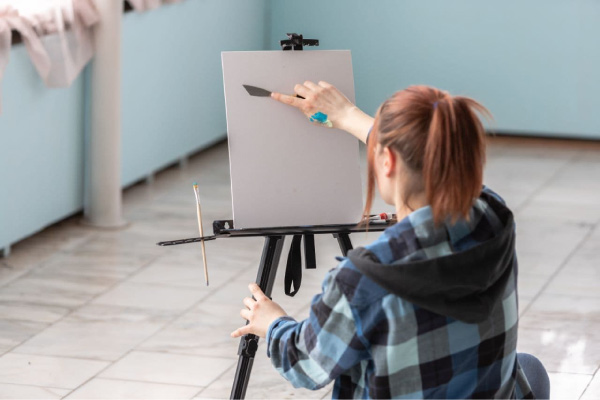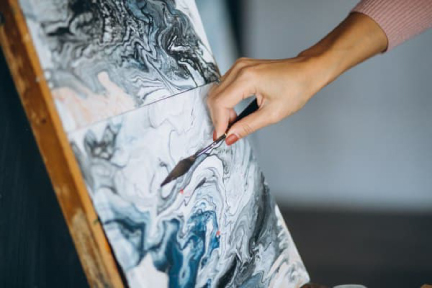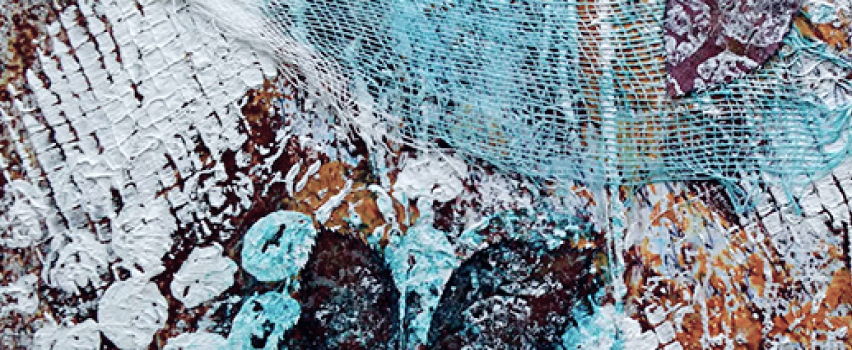
CONTENTS
Painting seems extremely difficult for people, who are not connected with the visual arts. It seems that in order to learn, you need to know a lot of strict rules of composition and color, building perspective, light and shadow, and much more. And this is true if it comes to academic painting.
If a soul requires painting, then you can start without a theoretical basis. You just have to concentrate on a pleasant pastime and not think about the result. Is it really that simple?
What is right-hemispheric painting?

Right-hemispheric painting is a technique aimed at turning off your rational principle and immersing yourself in the work. Try to remember the last time you drew something on paper and showed it to another person. Is there an internal barrier? Was it a flood of worries and shame at your inability to draw? Then it will not be easy to give free rein to your imagination and create “for the soul”.
The practice of right-hemispheric drawing or painting can be attributed to psychotherapy. It enhances brain performance and balances the emotional state. You learn to manage your experiences, regulate stress levels, and relax your mind when needed. And you can start at any free time at home.
How does it differ from the left-hemispheric one?
Left-hemispheric painting is exactly what is needed in academic painting. It requires a thorough analysis, a knowledge base and skills, multi-stage preparation for painting a picture. Is it worth talking about how long the process of creating a work takes according to all the rules?
Right-brain painting is aimed at a process, not a result: the process of learning, searching, self-expression and real creativity. At the same time, the area of painting is unlimited. The artist himself chooses the theme or purpose of the painting based on the feelings at the moment of creating images. Such artworks resonate with viewers, although they are not intended for them. After all, this kind of creativity is for the creator, not for the public.
Whole images pour out of the head onto the canvas, already with their own shadows, highlights and color combinations. The picture comes out unique, even if the depicted objects are simple and known to everyone, and even if you replicate it at different moments of your life.
You've probably heard that different hemispheres of the brain have their own sphere of responsibility among human abilities. The left one processes formally, logically and consistently, understands symbols and calculations. The right one is more intuitive, emotional, sensual, and it catches the wave of inspiration.
Many of us are guided by the left brain in our daily life to cope with tasks, plan and solve problems. And in long-term education in the visual arts, it is also used: for the correct image of trigonometric figures, calculating the distance between objects on a plane, coordinating lighting and other things. You get so used to painting analytically that there is no room for creativity on the canvas.
By focusing only on your feelings, you can relax, calm down and allow yourself to create without harsh self-criticism. Such a process is much more likely to be enjoyable, and the result will be a reflection of your present state of mind.
The history of the right-hemispheric painting birth
The above-described “functional specialization” of the hemispheres was first described by Roger Sperry, the Nobel laureate. In the late 70s, his theory formed the basis of the method of Dr. Betty Edwards. It is she, who today is considered the mother of right-hemispheric painting. Its idea was described in the book “The Artist Within”.
According to her, children easily turn off the left thinking zone for lack of a large amount of knowledge and experience and are fully involved in the process of creation. In adulthood, it is important to be able to do this with an effort of will. Only in this way you can look at the world from a non-trivial angle and depict it in a special way. In this vein, each of us knows how to paint no worse than writing and reading, the main thing is to let this skill reveal.
How to learn the left-hemispheric painting?
The creation of a painting using this technique depends on your perception of images, and not on artistic skills. Just give in to your intuition and act spontaneously: use the techniques that interest you without analyzing them. Let the flow of inspiration take you.
The first hurdle for beginners is the “fear of the white sheet”. It is not only white, but also limited: within its framework, you need to fit the whole composition. Get rid of it. Place a newspaper or something else under the sheet and make confident, sweeping strokes that go over the edges.
Painting with one hand is another barrier. It also needs to be overcome by using two brushes at the same time. It is advisable to try to paint with your fingers. So you will feel the consistency of paint, master new techniques and strokes, and briefly return to childhood.
Instead of white, take a colored sheet of paper, even black will do - and your imagination will begin to work with increased intensity.
If you have a child, introduce him to such creativity. Come up with a non-existent animal, building, or something else.
If you are right-handed, then painting with your left hand will be a serious challenge for your brain. If you are left-handed, learn to be right. Thus, brain areas that were not previously involved in this process are activated.
Practical exercises for the right-hemispheric painting

Take a contour image (coloring), turn it upside down and try to paint it in normal form. The left zone of perception will quickly give up, as its methods of analysis will be ineffective. But the right one can fully manifest itself.
At the same time, watch how you arrange the elements relative to each other. Paint them one to another, as if you are collecting a puzzle. Once you're in the process, focus and don't let yourself be distracted. Tune in back will not be easy.
Tape a piece of paper to the table. Focus on any texture: folds of your own palm, drapery of fabric, crumpled page, etc. Set a timer for 5 minutes and, without taking your eyes off the object, fix it in detail on paper.
Do not strive to draw all the lines as accurately as possible, it is much more important to synchronize the movements of the eyes and hands. Move 1 millimeter per second, no more. After this exercise, the visual perception will increase significantly, and everything around you will begin to look very different.
Place a small plastic or glass square in the frame. Fix it so that the selected object can be clearly seen through it. Use a permanent marker to draw all lines directly over the glass.
Then transfer your drawing onto a piece of paper. Hover over the path and do not change anything at this stage. It is important to learn how to portray objects as they are, and not their generally accepted symbols.
How is this technique useful?
First, painting, like any other type of creativity, helps a person to reveal potential and thinking outside the box. During the practice of right-hemispheric painting, the senses of perception, imagination, fine motor skills and even memory develop.
Secondly, it helps to fight fears: first, with the fear of a blank sheet, criticism of your technique, and then of everyday phenomena. Then you will be able to more confidently try yourself in classical painting.
Thirdly, this is a great relaxation option. You can relax and devote time only to yourself. Again, the goal of the technique is the process, not the result, and it shouldn't bother you at all.
The acquired skills will also affect everyday life: it will be easier to intuitively find interesting solutions, embody non-standard ideas and not be afraid to express yourself. By revealing your creative abilities, you will raise your self-esteem and, possibly, will be interested in some new direction in creativity.
As a result, your true state of mind will be displayed in a painting on a canvas. You will throw out emotions and get to know your inner world better. And if you wish, you can share your feelings with others, like a real artist.
Summary
Everyone can learn to paint by turning off the left hemisphere of the brain, regardless of their drawing skills. Give it a try and make sure you have creativity. Simple exercises can be done at home. The main thing is not to think about the result and completely dissolve in the flow of creativity. Consider this practice as a way to reveal yourself, improve the perception of the world around you and reach a new level of creation.

The earliest work of Leonardo da Vinci
A small painted tile caused quite a stir among the scientists of the art world. This is because some scholars believe that the recently discovered work is Leonardo da Vinci's earliest known work

Interesting facts about painting
Paintings hold the secrets of the creator. Sometimes we manage to solve them, but many of them continue to be riddles, or simply stay unnoticed.












Thank you, your review has been sent successfully.
It will be posted on the site after moderation.